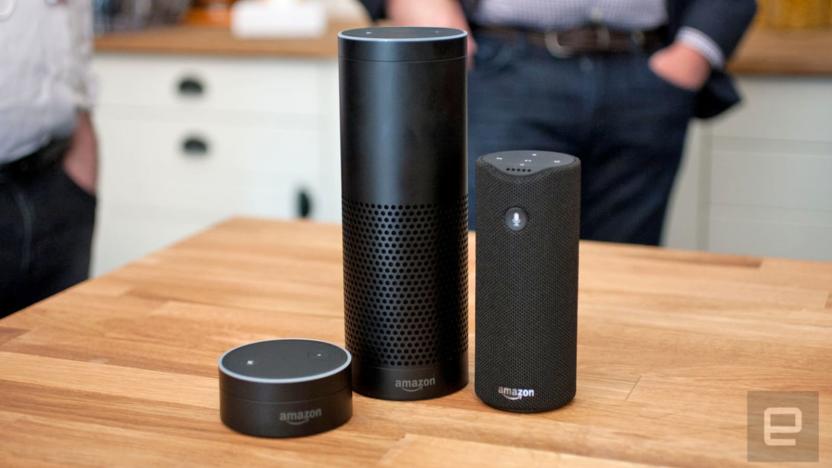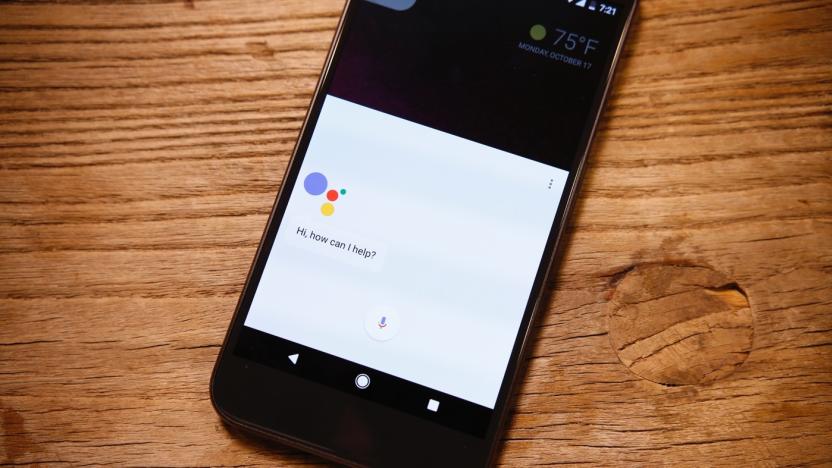IoT
Latest

Intel and Ericsson form an alliance to explore 5G applications
Intel is already showing off the building blocks of its 5G hardware at MWC and the big carriers are rushing to upgrade to the new standard, but the chipmaking giant is also launching a new initiative to build more than just faster cellular network. According to an announcement today, Intel and it's launch partners from Ericsson, Honeywell, General Electric and the University of California Berkeley have formed the 5G Innovators Initiative to explore and test new ideas that could change how connected devices, business, cities, and media operate. At launch, the 5GI2 will focus on the Industrial Internet of Things, including AR and VR applications for drones and first responders. The initiative will eventually expand to other industries as more groups join up, but 5GI2 hopes to build and test applications for autonomous vehicles, smart infrastructure, health care and media, among others. The pilot programs will include full "step-by-step blueprints" of the speed, security and connectivity requirements so they can be easily replicated or open-sourced. "5G is not simply about making smart phones faster," Intel VP and General Manager of Next Generation Standards Asha Keddy said in a statement. "It's about the machines and things that will deliver an entirely new smart and connected future. Building our 5G future requires a new approach to industry collaboration and development."

When vending machines attack (a university)
We are marching toward certain doom at the hands of an angry Skynet of our own invention. Need proof? This week a school was attacked by its own soft drink vending machines. You read that right.

IBM and Indiegogo are bringing Watson's smarts to the masses
IBM sees a big future in the Internet of Things. The company unveiled its $200 million IoT headquarters in Munich this week as part of its planned $3 billion investment in the connected devices industry. So far, however, the tech behemoth has mostly lent Watson's brains to larger companies and research projects. That's about to change thanks to a new partnership from IBM, Indiegogo and Arrow Electronics that promises to give independent developers and entrepreneurs access to those same machine learning tools.

Amazon Echo and Google Home want to be your new house phone
Right now, you can order a pizza, manage your to-do list and call an Uber on Amazon Echo and Google Home. The latest development from the smart speakers would give us yet another reason to leave our phones in our pocket. The Wall Street Journal reports that Amazon and Google are considering adding telephone functionality to their devices, but it won't be easy.

Makeblock's Lego-like 'Neuron' teaches kids robotics and code
Makeblocks, a company known for kid-friendly robotics and DIY hovercraft-drones, is launching a new gadget-building platform called Neuron. It's like Lego meets Littlebits -- you get over 30 blocks with different functions that kids can snap together and then program to create science experiments or gadgets like an internet-connected cat feeder. The system is platform agnostic, the company says, so it can work with products like Lego and even Microsoft's Cognitive Services AI platform.

Google Pixel's Assistant AI upgraded for smart home control
At Google I/O last May, the tech giant announced its own voice-powered hub to rival Amazon's Echo: the Home, which would be powered by their AI helper, Assistant. The Siri-like software was promoted as a standard feature on the search titan's first phone, the Pixel, which came out later in fall. But Google announced a plan weeks ago to bring the hub and the help back together, promising to bring some of Home's connected device control to the company's smartphone line. Today, they started rolling out Home Control for some versions of their mobile platform, allowing users to use voice commands to fiddle with their network of connected home devices.

An unofficial ACLU Dash Button offers one-touch donations
Amazon's Dash Buttons offer one-click ordering for items your purchase through that Prime membership on a regular basis. In fact, there are over 250 of the buttons from a range of different brands. Last May, the online retailer revealed a $20 IoT version that can be programmed to help with other tasks besides just buying products. Designer and programmer Nathan Pryor is using the handy connected button to provide some relief every time he reads a tweet from President Trump or a headline about the latest happenings at the White House.

Control your connected home with a wave of your hand
The IoT-powered smart home has caught the tech world's fancy for years, promising domestic command at your fingertips. But beyond set-and-forget environmental preferences, connected devices are usually configured via smartphone app or voice-controlled through a hub. But if you want to flick on your IoT machines with a wave or table tap, Hayo has launched an Indiegogo campaign to bring spatial remotes to your living room.

Louisville turns your smart lights red when air quality suffers
Citizens of Louisville, Kentucky just got a way to make their smart homes even smarter, thanks to IFTTT and the local city government. According to an announcement from Mayor Greg Fischer, the city has launched its own IFTTT channel that can tie public air quality data directly to smart home devices and other connected gadgets. With the city's home-baked applets, residents can get push notifications for days when the air quality reaches a certain level or, if it gets particularly bad, the air quality can actually be displayed in the colors of a Philips Hue connected lightbulb.

Hackers use streaming devices to make radio stations play 'FDT'
Vulnerabilities in the Internet of Things can have odd results, as we witnessed last year when radio stations suddenly started playing archived clips from a furry podcast. More recently, unknown hackers have exploited the Barix IP streamers some stations use to syndicate content for another purpose: playing YG's song "FDT." According to the Associated Press, a South Carolina station ended up playing the song on a loop for 15 minutes Monday night, following incidents on small stations in other states.

Mozilla shutters its connected devices division
Mozilla will close its gadgets division, laying off some 50 employees working on products for connected devices (like smart TVs, for example) in the process. While the company wouldn't comment on the specific number of employees affected, it offered the following statement:

Raden's connected carry-on is sleek and smart, but cramped
I don't think there's anything more crucial to a frequent traveler's arsenal than a reliable carry-on, but does it need to be smart too? A cottage industry of connected luggage makers seems to think so. While some companies have focused on packing their bags with components, a startup called Raden is trying to take a more measured approach. That's where its A22 connected carry-on comes in: It's a fascinating attempt at melding technological convenience with the simplicity of high-end luggage. So what exactly does $295 get you?

Use Google Home to control WeMo and Honeywell connected devices
Since Home arrived a few months ago, Google has been regularly adding new features to the compact speaker and its virtual assistant. Today, the company announced that the connected device can now be used to control smart home gadgets from Belkin's WeMo line and Honeywell. This adds more options for controlling lights, switches, thermostats and more with a simple "Ok Google" voice command.

The best smart smoke alarm
By Jennifer Pattison Tuohy This post was done in partnership with The Wirecutter, a buyer's guide to the best technology. When readers choose to buy The Wirecutter's independently chosen editorial picks, it may earn affiliate commissions that support its work. Read the full article here. We can't overstate the importance of having functioning, reliable smoke detectors in your home. From 2007 through 2011, almost a quarter of all home fire-related deaths in the US occurred in homes with nonworking smoke alarms. Though any functioning smoke alarm will alert you to problems if you're at home, a smart alarm can alert you anywhere your smartphone has an Internet connection. After extensive testing by a former firefighter, we found that the second-generation Nest Protect smoke and carbon monoxide alarm is the best smart smoke alarm.

Smart air freshener lets you select scents with your phone
Thanks to the internet of things, we have the ability to control our home's lighting and temperature at the touch of a button. But what about the smell? For that, we're left with shoving a Glade plug-in air freshener into a socket or opening a window. That's set to change with the introduction of Moodo, a SensorWake-esque device that's designed to customize your home's scent at will.

FTC vs D-Link: All bark, no bite
Most routers are bad. Bad to their little router bones. But they were made that way. And when you get one of the bad ones in your home, they sit there like little privacy and security time bombs, just waiting to become conduits of evil in your house. You think I'm joking. But if you look at the state of router security, then you will know this is a big problem. And it's one that's nearly impossible for normal people to fix.

Glympse brings its location sharing to connected home devices
The Internet of Things is set to expand in a big way if all the voice-controlled and Alexa-equipped tech we saw at CES last week is any indication. Glympse has been offering handy location sharing from its apps for quite some time, but now the company is diving into the connected home. With FamilyMap, Glympse allows a group of people to privately share location details not only through an app, but with the help of connect devices like smart appliances, smart TVs or a home assistant like Alexa.

Never worry about leaving the stove top on ever again
The first time someone says "smart stove knobs," you instantly conclude that the technology industry needs an intervention. But while the Inirv React's concept seems gently ridiculous, the product itself makes you wonder why nobody thought of this before. Essentially, it's a series of powered dials that sit on your gas range, letting you turn them off remotely with your smartphone. Even more impressive, however, is that a nearby sensor can do it automatically if it senses heat, gas or that you've left the house.

These connected shoes could help you run faster, smarter and more safely
Power laces and 3D-printed materials aren't the only things shaping the future of footwear. If Sensoria and Vivobarefoot have their way, people could soon be wearing shoes packed with tech to help them run faster, smarter and more safely. Here at CES, the companies revealed a pair of concept sneakers that feature two removable chips and four pressure sensors near the heel area. Not only can the system measure speed, pace and track you via GPS, but it's also smart enough to learn your stride rate and foot-landing technique.

Smart Cube turns any drawer into a Bluetooth-controlled lockbox
One of the latest devices to go from crowdfunding to CES is this Bluetooth-connected lock from Smart Armor. The Cube uses Bluetooth Low Energy (BLE) to pair with your phone, and can unlock whenever it's in range (or from further away, if you have a Bluetooth router or other device to control it). Simply mount the device in a drawer or box that you'd prefer remain closed to prying eyes, fingers or other appendages, and it can tighten closed. Even if someone tries to tamper with the device, it will send out an alert. Mounted with double-sided tape, it can stand up to 100 pounds of force, or owners can mount it with the provided holes.









